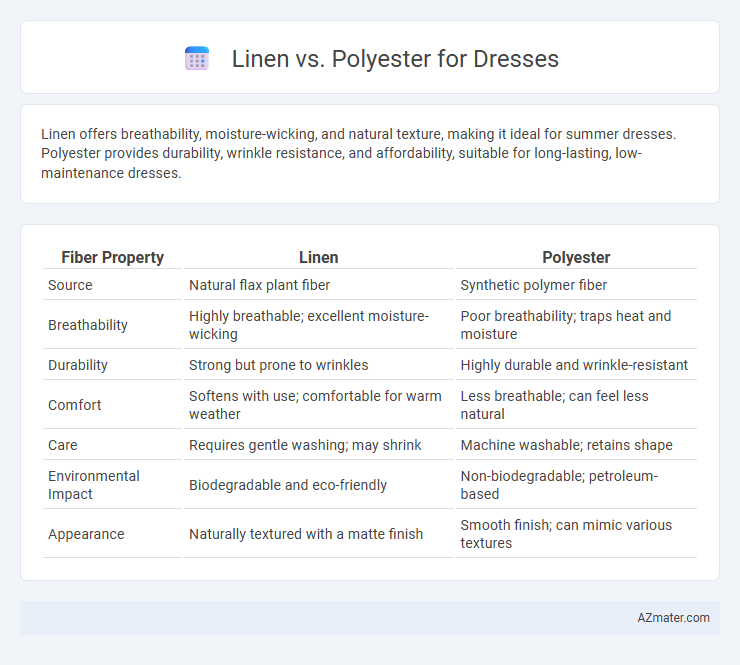Linen offers breathability, moisture-wicking, and natural texture, making it ideal for summer dresses. Polyester provides durability, wrinkle resistance, and affordability, suitable for long-lasting, low-maintenance dresses.
Table of Comparison
| Fiber Property | Linen | Polyester |
|---|---|---|
| Source | Natural flax plant fiber | Synthetic polymer fiber |
| Breathability | Highly breathable; excellent moisture-wicking | Poor breathability; traps heat and moisture |
| Durability | Strong but prone to wrinkles | Highly durable and wrinkle-resistant |
| Comfort | Softens with use; comfortable for warm weather | Less breathable; can feel less natural |
| Care | Requires gentle washing; may shrink | Machine washable; retains shape |
| Environmental Impact | Biodegradable and eco-friendly | Non-biodegradable; petroleum-based |
| Appearance | Naturally textured with a matte finish | Smooth finish; can mimic various textures |
Introduction to Linen vs Polyester for Dresses
Linen, derived from flax fibers, offers breathability, natural moisture-wicking, and a crisp texture ideal for warm-weather dresses, while polyester, a synthetic fiber, provides durability, wrinkle resistance, and color retention. Dresses made from linen are favored for their eco-friendly qualities and comfort in hot climates, whereas polyester dresses are valued for low maintenance, affordability, and longevity. Choosing between linen and polyester depends on desired fabric performance, care requirements, and environmental considerations.
Key Differences Between Linen and Polyester
Linen, derived from flax fibers, offers superior breathability, moisture-wicking properties, and a natural, textured appearance ideal for warm weather dresses. Polyester, a synthetic fiber, excels in durability, wrinkle resistance, and color retention, making it suitable for long-lasting, low-maintenance garments. Key differences include linen's eco-friendliness and biodegradability versus polyester's affordability and quick-drying features.
Comfort and Breathability: Which Fabric Wins?
Linen offers superior breathability due to its natural fibers and loose weave, making it ideal for hot weather as it allows air to circulate and moisture to evaporate quickly. Polyester, a synthetic fabric, tends to trap heat and moisture, leading to less comfort and increased perspiration during wear. For maximum comfort and breathability in dresses, linen is the preferable fabric choice.
Durability and Longevity Comparison
Linen dresses offer exceptional durability due to their natural fiber strength, resisting wear and tear even after multiple washes, while polyester is known for its high resistance to stretching, shrinking, and wrinkles, contributing to long-lasting shape retention. Linen may show signs of aging like softening and minor fraying over time, whereas polyester maintains its vibrant color and structural integrity longer under frequent use and harsh washing conditions. Choosing between linen and polyester depends on the desired balance of natural breathability and eco-friendliness against synthetic resilience and minimal maintenance.
Style and Appearance: Textures and Colors
Linen dresses offer a natural, breathable texture with a slightly crinkled appearance that exudes casual elegance and timeless charm. Polyester dresses can mimic various fabrics with smoother, more consistent finishes, often providing vibrant and lasting colors that resist fading. While linen emphasizes organic, matte tones suited for relaxed styles, polyester excels in bold, glossy hues ideal for polished, modern looks.
Maintenance: Washing and Care Requirements
Linen dresses require gentle washing in cold water and air drying to prevent shrinkage and maintain fabric integrity, while polyester dresses offer easier maintenance with machine washing and quick drying properties. Linen is prone to wrinkles and may need ironing at medium heat, whereas polyester resists wrinkles and typically requires little to no ironing. Both fabrics benefit from avoiding bleach, but polyester's durability allows more flexibility in washing cycles and care routines.
Environmental Impact: Sustainability Concerns
Linen is derived from flax plants, a renewable resource that requires less water and pesticides compared to cotton and polyester production, making it a more sustainable fabric choice. Polyester, a synthetic fiber made from petroleum, contributes significantly to microplastic pollution and fossil fuel depletion, raising serious environmental concerns. Biodegradability and lower carbon footprint position linen as a more eco-friendly option for environmentally conscious dressmakers and consumers.
Cost Comparison: Linen vs Polyester
Linen dresses typically cost more than polyester due to natural fiber sourcing and labor-intensive production processes, with prices often ranging from $80 to $300. Polyester dresses, made from synthetic fibers, are generally more affordable, priced between $20 and $100, making them a budget-friendly option. The higher initial investment in linen reflects its breathability and durability, while polyester offers cost efficiency and easier maintenance.
Best Occasions for Linen and Polyester Dresses
Linen dresses excel for warm-weather occasions like beach weddings, garden parties, and casual summer outings due to their breathability and moisture-wicking properties. Polyester dresses are ideal for formal events, evening wear, and situations requiring wrinkle resistance and durability, such as office functions or travel. Choosing between linen and polyester depends on the event's temperature, formality, and desired comfort level.
Final Verdict: Choosing the Right Fabric
Linen offers breathability, moisture-wicking properties, and a natural matte finish, making it ideal for warm weather dresses with a casual, elegant look. Polyester provides durability, wrinkle resistance, and vibrant color retention, suitable for structured dresses requiring low maintenance and longevity. Choosing the right fabric depends on whether comfort and natural texture (linen) or practicality and durability (polyester) are the priority in the dress selection.

Infographic: Linen vs Polyester for Dress
 azmater.com
azmater.com